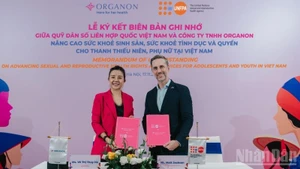With a total budget of US$400,000 for the three-year period, the cooperation targets to provide quality evidence to help develop policies and programmes to address the burden of diseases related to HPV and facilitate the expansion of HPV vaccinations in Vietnam in accordance with the priorities of the local health sector.
In addition, it also encourages positive communication and evidence-based advocacy to inspire stakeholders in addressing the burden of HPV-related diseases, including facilitating and supporting the HPV vaccination scale and assisting the construction of a national roadmap for HPV vaccinations in Vietnam.
Astrid Bant, UNFPA Representative in Vietnam, stressed that the signing affirms the efforts of the Health Ministry’s General Department of Preventive Medicine, the National Institute of Hygiene And Epidemiology (NIHE), UNFPA and MSD in implementing the HPV vaccination programme nationwide.
In Vietnam, according to a survey on cervical cancer performed in 2018, there are 12 new cases a day and seven women have died from cervical cancer. The number of deaths is two to three times higher than the fatalities from pregnancy-related complications during pregnancy and childbirth. Globally, the number of cervical cancer deaths is much greater than the number of fatalities from HIV, tuberculosis and malaria combined.
The first HPV vaccine became available in 2006. Research results have demonstrated that HPV vaccinations for girls has a high cost effectiveness in preventing cervical cancer, which have been proved in 156 countries, including Vietnam and 10 other nations in the Southeast Asia.
In Vietnam, NIHE and the non-profit global health organisation PATH successfully implemented a pilot project during 2007-2008 to test HPV distribution strategies. The project results showed that both strategies for providing HPV vaccines at schools and clinics achieved very high coverage (over 96% and 98%, respectively). However, due to lack of resources, the project has not been replicated.
In 2015, the Ministry of Health developed a National Action Plan on cervical cancer prevention and control for the 2016-2025 period, laying the orientation and basis for improving access to HPV vaccines. However, coverage of HPV vaccinations in Vietnam is still low.
Astrid Bant said one of the main obstacles in expanding the HPV vaccination programme is the lack of national budget for the programme implementation. The cost of HPV vaccines on the market is still high, ranging from US$45-100 per dose depending on the providers. However, Vietnam still has the opportunity to apply a procurement mechanism to continue buying HPV vaccines at preferential prices – the price that the Global Alliance for Vaccines and Immunisation (GAVI) is offering – US$4.5 per dose from now to 2025. Some provinces and cities have mobilised resources to support this solution.
According to the UN official, along with UNFPA, the General Department of Preventive Medicine and NIHE have been active in communication activities during the vaccine implementation in the five localities of Hanoi, Quang Ninh, Khanh Hoa, Can Tho and Dong Thap in the first phase.
In this initiative, it is proposed to adopt a new financing and procurement mechanism, using provincial budgets after being approved by the provincial People's Councils. The budget will be transferred and aggregated into the Ministry of Health's budget, then will be used by the National Centralised Drug Procurement Centre to procure HPV vaccines in a centralised manner through the United Nations Children's Fund (UNICEF). The MSD support will help speed up the work in the preparation phase so that the HPV vaccines can be implemented in the selected localities by 2021.
Cervical cancer remains a major killer of women. Caused by HPV, cervical cancer claims the lives of more than 300,000 women every year, of which 85% live in developing countries, according to the World Health Organisation. Cervical cancer can be prevented and treated if detected at an early stage and treated effectively. Early prevention and treatment are also highly cost-effective.
















